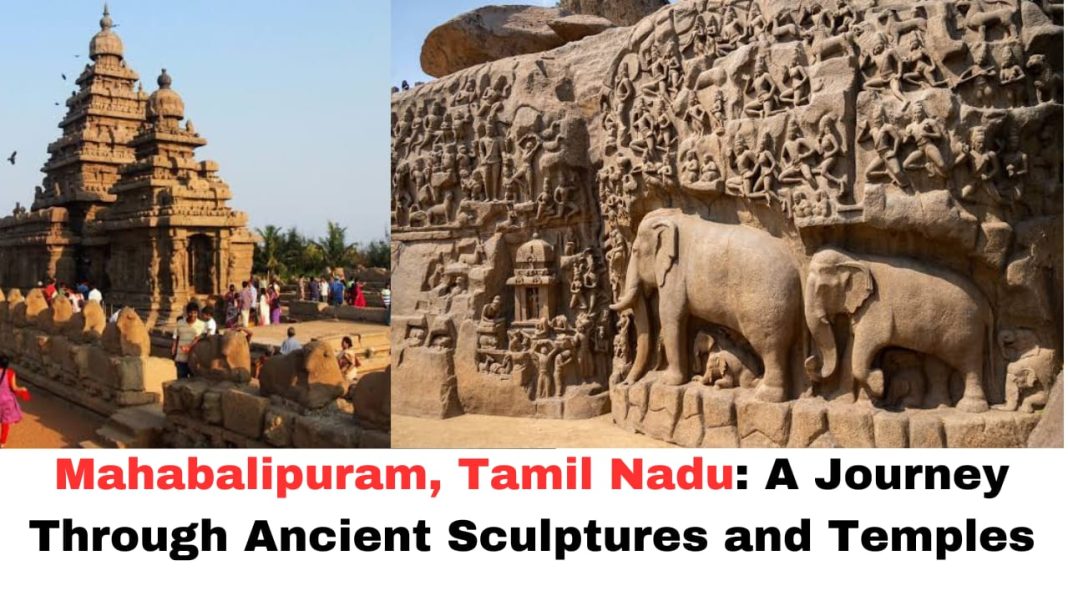Digital News Guru Tamil Nadu Desk:
Nestled along the southeastern coast of India, Mahabalipuram (also known as Mamallapuram) is an ancient town in Tamil Nadu that captivates visitors with its rich history, stunning architecture, and awe-inspiring sculptures. This UNESCO World Heritage Site is famous for its intricate rock-cut temples, monolithic structures, and elaborate stone carvings, reflecting the grandeur of the Pallava dynasty, which ruled the region between the 7th and 9th centuries. Mahabalipuram is a remarkable destination for history lovers, architecture enthusiasts, and anyone looking to experience India’s cultural and artistic heritage.
Historical Significance of Mahabalipuram
Mahabalipuram’s history is deeply intertwined with the Pallava dynasty. The Pallavas were one of the most powerful dynasties of Southern India and were known for their patronage of art, architecture, and religion. The town of Mahabalipuram, which served as the Pallava capital for a period, flourished under the reign of King Narasimhavarman I, also known as Mamalla. The name “Mahabalipuram” is derived from the legendary demon king Mahabali, though historical evidence suggests it was also named after King Mamalla due to his patronage of the arts.
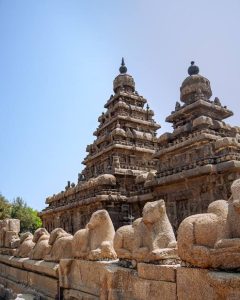
The town became a hub of artistic and cultural expression, and the Pallavas commissioned grand temples, monumental sculptures, and intricate rock-cut cave temples. This made Mahabalipuram one of the most important centers of early Dravidian architecture and sculpture, showcasing a synthesis of indigenous and foreign artistic influences. These monuments are among the finest examples of ancient Indian architecture and sculpture, depicting stories from Hindu mythology, royal patronage, and religious devotion.
Architectural Wonders of Mahabalipuram
Mahabalipuram is home to a collection of remarkable monuments, many of which are carved directly into the rock. These architectural feats display the ingenuity and skill of ancient craftsmen and offer a glimpse into the region’s rich cultural history.
- The Shore Temple
One of the most famous monuments in Mahabalipuram is the Shore Temple, a UNESCO World Heritage Site. This ancient structure is located on the edge of the Bay of Bengal and is an exquisite example of Pallava architecture. Built in the 8th century, the Shore Temple is dedicated to the Hindu gods Shiva and Vishnu and consists of a complex of temples. The temple is characterized by its pyramid-like structure, made of intricately carved granite stones, and its stunning location overlooking the sea. The Shore Temple is also notable for its architectural design, which marks a transition from the early rock-cut temples to free-standing stone structures in South India.
- The Pancha Rathas (Five Chariots)
Another iconic feature of Mahabalipuram is the Pancha Rathas, a group of five monolithic temples carved out of single rock formations. Each of these temples is designed to resemble a chariot and is associated with a specific figure from Hindu mythology. The temples are named after the five Pandava brothers from the epic Mahabharata: Yudhishthira, Bhima, Arjuna, Nakula, and Sahadeva. The rathas are carved in various architectural styles, showcasing the intricate craftsmanship and engineering capabilities of the Pallava dynasty. The Pancha Rathas is a remarkable example of monolithic architecture and a testament to the artistic excellence of the period.
- The Descent of the Ganges (Arjuna’s Penance)
The Descent of the Ganges, also known as Arjuna’s Penance, is one of Mahabalipuram’s most famous and largest rock relief sculptures. Carved on a massive granite rock, this relief depicts a scene from the Mahabharata, where the hero Arjuna performs penance to Lord Shiva to obtain the weapon that will help him defeat his enemies. The sculpture shows Arjuna standing in a meditative pose while various gods, animals, and mythical creatures watch over him. The intricate details of the carvings, including figures of celestial beings and animals, make this relief one of the finest examples of ancient Indian art.
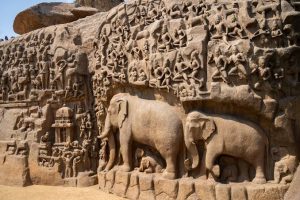
- Cave Temples
Mahabalipuram also features several rock-cut cave temples, which are carved into the hillside along the town’s landscape. These caves are adorned with beautifully detailed sculptures of Hindu gods and goddesses, showcasing the region’s devotion to religious practices. The most famous cave temples include the Varaha Cave Temple, dedicated to Lord Vishnu, and the Krishna Cave Temple, which portrays scenes from the Mahabharata. These cave temples are early examples of rock-cut architecture and demonstrate the Pallava kings’ commitment to religious and artistic expression.
- The Krishna Mandapam
The Krishna Mandapam is another remarkable monument in Mahabalipuram. This small temple, carved out of a single rock, is adorned with intricate reliefs depicting the life of Lord Krishna, one of the most beloved gods in Hinduism. The carvings showcase various scenes from Krishna’s life, including his childhood adventures and his divine acts. The Krishna Mandapam is known for its elaborate artistry and the delicate detailing of the figures, making it a popular attraction for visitors.
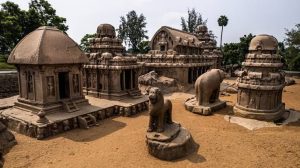
Cultural and Religious Significance
Mahabalipuram holds immense cultural and religious significance for Hindus, as it is home to numerous temples and monuments dedicated to various gods and goddesses. The town’s religious landscape reflects the deep devotion of the Pallava rulers, who were strong patrons of Hinduism. The sculptures and temples in Mahabalipuram are a testament to the Pallavas’ religious beliefs and their desire to leave behind a lasting legacy of divine grandeur.
The presence of the Shore Temple, the Pancha Rathas, and other religious structures makes Mahabalipuram an important pilgrimage site. Visitors come not only to marvel at the incredible architecture but also to experience the spiritual atmosphere that pervades the area. The monuments continue to attract devotees and tourists alike, with many choosing to visit during religious festivals and special events.
Tourism and Modern Mahabalipuram
Today, Mahabalipuram is a popular tourist destination, drawing visitors from across the globe. The town’s proximity to Chennai (about 60 kilometers away) makes it easily accessible, and its historical significance, along with its stunning natural beauty, makes it a must-visit location for anyone interested in India’s ancient past.
The town has evolved over the years, but it has managed to retain its charm and historical importance. Apart from visiting the ancient monuments, tourists can explore the local markets, where artisans sell hand-carved sculptures and other handicrafts. Mahabalipuram is also known for its pristine beaches, making it an ideal destination for those seeking a mix of history, culture, and relaxation.
Preservation Efforts
As Mahabalipuram attracts more visitors, preserving the site’s cultural and architectural heritage has become a priority. The Archaeological Survey of India (ASI) and local authorities have undertaken various preservation and restoration efforts to protect the monuments from the effects of weather, pollution, and human intervention. These efforts include cleaning and repairing the sculptures, monitoring the impact of tourism, and limiting construction around the area.
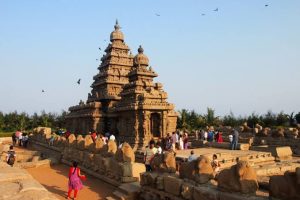
Conclusion
Mahabalipuram is a treasure trove of ancient Indian art, architecture, and history. From its intricate rock-cut temples to its awe-inspiring sculptures, the town offers a fascinating journey through the past. As a UNESCO World Heritage Site, Mahabalipuram continues to be a beacon of India’s rich cultural legacy, and its monuments stand as a tribute to the skill, devotion, and vision of the Pallava rulers. A visit to Mahabalipuram is not just a trip to see ancient structures but an opportunity to immerse oneself in the grandeur of a bygone era that continues to inspire and captivate all who venture there.
You May Also Read: Abhishek Bachchan and Aishwarya Rai Bachchan Attend Daughter Aaradhya’s School Event



